If you are new to the world of fish keeping, you may have heard of the term “community fish” used to describe one fish or another. But what does it mean?

A community tank is one in which the occupants share similar characteristics, water parameters, and feeding needs.
A community fish is one that can exist in such an aquarium with a variety of other species without causing undue aggression or harm.
Aggression can come in the form of chasing, nipping, or severe injury, depending on the fish’s temperament.
It is a common practice to pair fish of similar temperaments for the optimal community tank. The categories typically fall into peaceful, semi-aggressive, and aggressive.
For this article, we focused on fish that would be suitable for a peaceful community aquarium. We hope you enjoy!
In this article
- Peaceful Community Fish
- 1. Ember Tetra (Hyphessobrycon amandae)
- 2. Guppies
- 3. Platies
- 4. Swordtails
- 5. Mollies
- 6. Cherry Barb (Puntius titteya)
- 7. Harlequin Rasbora (Trigonostigma heteromorpha)
- 8. Otos (Otocinclus spp.)
- 9. Honey Gourami (Trichogaster chuna)
- 10. Neon Tetra (Paracheirodon innesi)
- 11. Sparkling Gourami (Trichopsis pumila)
- 12. Pencilfish (Nannostomus spp.)
- 13. Cory Catfish (Corydoras spp.)
- 14. Kribensis (Pelvicachromis spp.)
- 15. German Blue Ram (Microgeophagus ramirezi)
- 16. Clown Pleco (Panaque maccus)
- 17. Apisto (Apistogramma spp.)
- 18. Blue-Eyed Forktail, Pseudomogil spp. (Pseudomugil furcatus)
- 19. Odessa Barb (Pethia padamya)
- 20. White Cloud Mountain Minnow (Tanichthys albonubes)
- 21. Kuhlii Loach (Pangio kuhlii)
- 22. Gold Barb (Puntius semifasciolatus)
- 23. Silver Tetra (Ctenobrycon spilurus)
- 24. X-Ray Tetras (Pristella maxillaris)
- 25. Festivum Cichlid (Mesonauta festivus)
- 26. Keyhole Cichlid (Cleithracara maronii)
- 27. Moonlight Gourami (Trichopodus microlepis)
- 28. Glass Catfish (Kryptopterus vitreolus)
- 29. Flag Acara (Laetacara curviceps)
- 30. Common Hatchetfish (Gasteropelecus sternicla)
- 31. Dwarf Rainbowfish (Melanotaenia maccullochi)
- 32. Dwarf Neon Rainbowfish (Melanotaenia peacox)
- 33. Boesemani Rainbowfish
- Closing Thoughts
Peaceful Community Fish
1. Ember Tetra (Hyphessobrycon amandae)
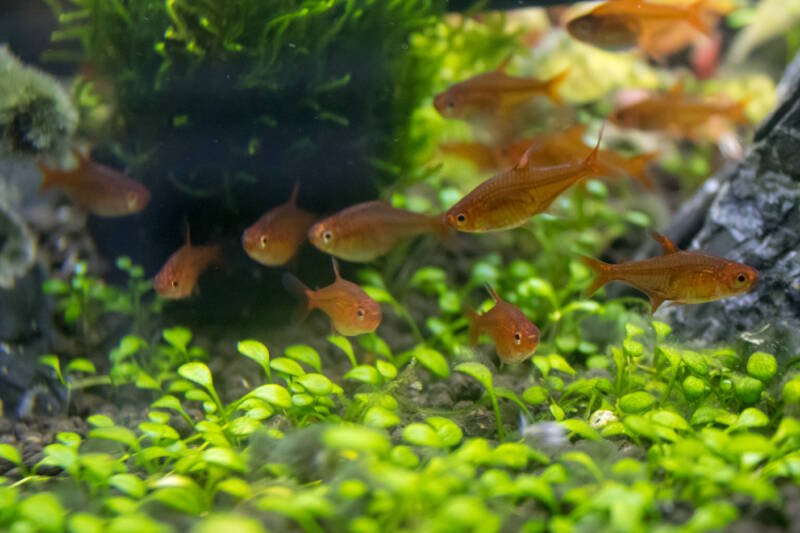
- Difficulty: Easy
- Diet: Omnivore
- Tank Size: 10 gal (40 l)
The tiny, semi-transparent ember tetra positively glows with a soft orange color.
They look spectacular when multiple fish school together in the tank and need to be well fed to display their best coloration.
The lifespan of this fish is short, two to four years but can be toward the longer end if they are kept in well-planted tanks.
These fish prefer the middle to upper levels of the tank. Add subdued lighting and a dark substrate to make their color pop.
The adaptable ember tetra can handle various water conditions, including medium hardness water, although it prefers softer, slightly acidic water.
Ember tetras are active, peaceful swimmers that reach around 0.8 inches (2 cm) in length.
As such, they need to be placed with smaller, similarly tempered tank mates. Consider pencilfish or neon tetras as excellent ember tetra companions.
Livebearers: “The Big Four”

Livebearing fish bring a unique experience to your tank. Unlike egg layers, livebearers mature the eggs inside their bodies and give birth to free-swimming young.
As the young are born larger and fully developed (rather than having to pass through a larval stage), they are easier to care for and suffer lower mortality rates.
These fish from the Poeciliidae family include guppies, mollies, platies, and swordtails.
2. Guppies
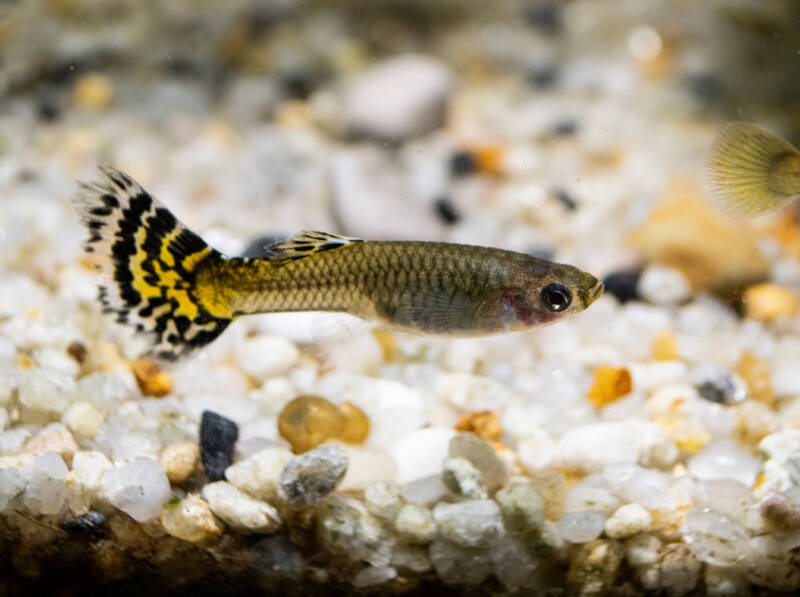
Guppies are by far one of the easiest to care for species out there.
Plus, they have beautiful, varied colors, graceful fins, and a high activity level that makes them fun to watch.
3. Platies

Pick any color, and there is likely a platy in that hue. These peaceful fish not only look stunning in any tank, but they are hardy, easy to keep, and active.
4. Swordtails
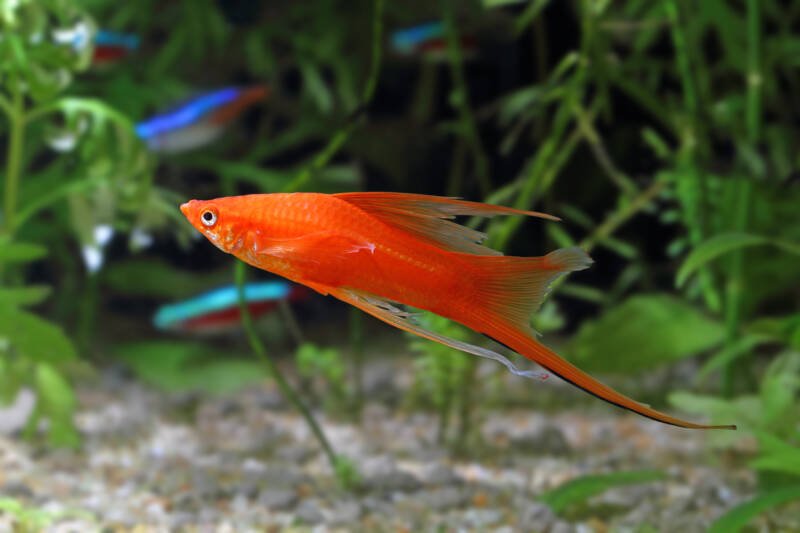
While they come in fewer colors than do guppies or platies, swordtails have fabulous personalities and unique caudal fin shapes.
They are highly social and love to interact with others of their kind. Males can be somewhat aggressive, so plan on a male to female ratio of 1:2.
5. Mollies

Mollies are one of the larger livebearing fish, reaching around 4.5 inches (11 cm).
They come in an impressive range of colors and fin shapes, and while hardy, require slightly more attention to water care than others.
6. Cherry Barb (Puntius titteya)
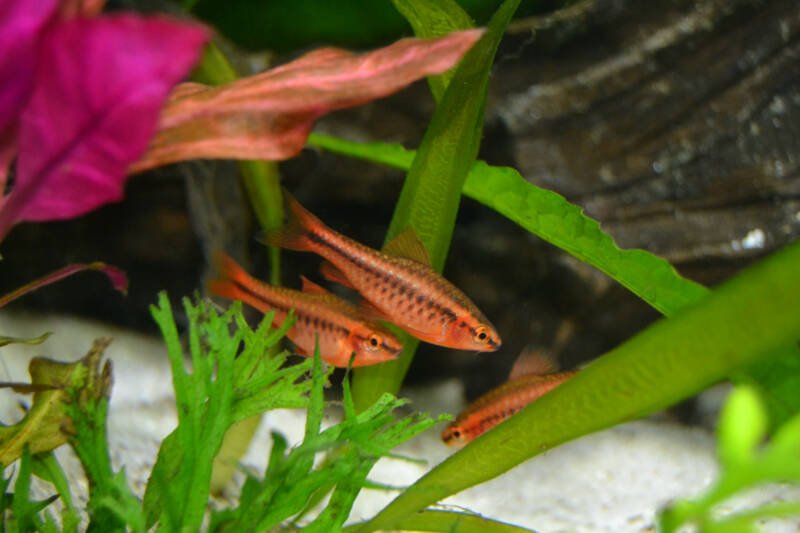
- Difficulty: Easy
- Diet: Omnivore
- Tank Size: 25 gal (100 l)
Cherry barbs are well loved for their beautiful coloration, with males being more vivid than females.
Variations in breeding stock and feeding practices result in colors ranging from a lighter pink or salmon color to a rich red.
The males can be slightly aggressive with each other. Therefore, keep a maximum of two males and the rest females (or a 1:2 ratio of males to females).
These fish are not nippy, however, and make great tank mates.
To replicate their natural habitat, provide these fish with a lushly planted tank, including plenty of floating plants and a dark, silty substrate to show off their vibrant colors.
Plants and other decorations give cherry barbs the security of a hiding space. They can be quite shy in a bare tank.
7. Harlequin Rasbora (Trigonostigma heteromorpha)

- Difficulty: Easy
- Diet: Omnivore
- Tank Size: 10 gal (40 l)
This small fish is hardy and so easy to care for. Their pink/orange bodies have a unique black shape on their sides that resembles the patterns on jester costumes.
Harlequins stay small, at only two inches (5 cm) in length, fully grown and look incredible in a school.
A dark substrate combined with plenty of broad-leafed plants and some driftwood is a perfect environment for harlequin rasboras.
Leave plenty of swimming space for these active fish to enjoy.
Harlequin rasboras are peaceful and perfect to pair with other small, non-aggressive species.
Because of their small size, they can be targets for larger fish and feel most comfortable in a school of eight to 10.
8. Otos (Otocinclus spp.)

- Difficulty: Easy
- Diet: Herbivore
- Tank Size: 10 gal (40 l)
Adorable and helpful? That’s the oto cat!
There are at least 20 species of this tiny freshwater fish that have been identified so far, which means a wide variety of colors and patterns to add interest to your freshwater aquarium.
The adult size of these fish varies by species but does not typically go over two inches (5 cm).
Still, they are highly proficient algae eaters, using their oversized sucker mouths to clean gravel, plants, and aquarium glass.
This catfish is often recommended for peaceful community tanks with smaller fish, especially fish that occupy the middle to upper levels of the tank.
You will need a group of at least six to eight fish. This schooling fish needs the proximity of other otos to be comfortable.
9. Honey Gourami (Trichogaster chuna)
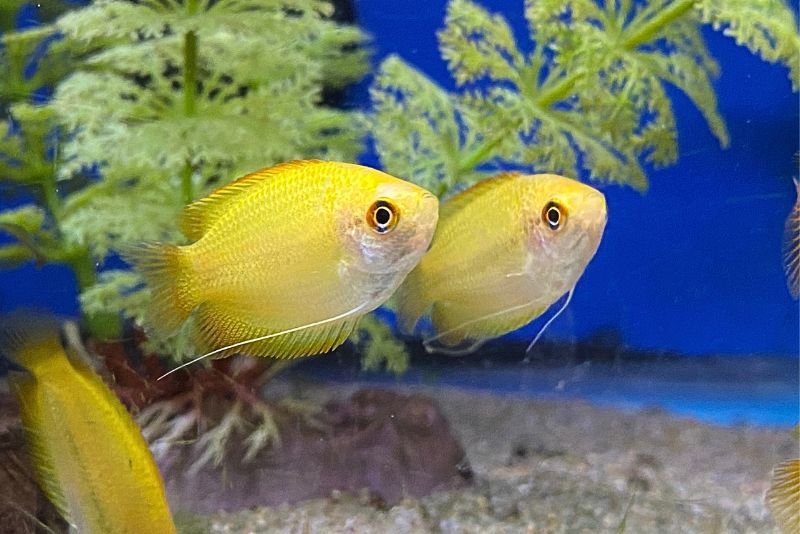
- Difficulty: Easy
- Diet: Omnivore
- Tank Size: 10 gal (40 l)
The honey gourami is one interesting fish. First, they hunt by squirting a stream of water at insects and knocking them into the water where they can be caught.
Next, they have a labyrinth organ that allows them to intake oxygen directly from the air.
Finally, these fish are bubble nest builders, which is interesting to see.
These fish will not harm live aquatic plants. Make sure they can access the water surface and choose a long tank over a tall one.
Honey gouramis are fairly easygoing and can live singly or in pairs. These fish may be shy at first, but if kept in a group of four to six, they will display their most active behaviors.
In fact, their personalities are so outgoing that some say they can even recognize their owners.
10. Neon Tetra (Paracheirodon innesi)
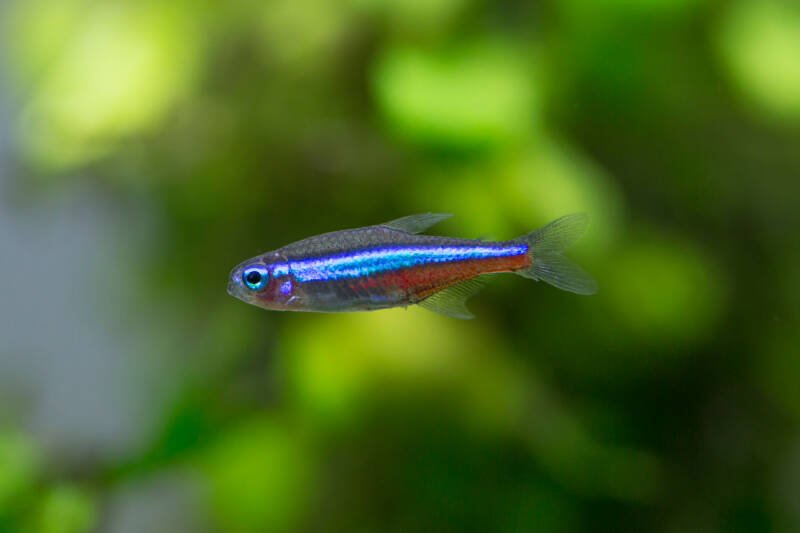
- Difficulty: Easy
- Diet: Omnivore
- Tank Size: 10 gal (40 l)
Tiny, brightly colored and ever so popular, the neon tetra is easy to care for and suitable for beginners.
They need a tank that is well-cycled, so learn the basics of stabilizing the nitrogen cycle and aim for a pH of 6.5 or lower.
Once the tank is cycled, add any other fish to the community tank and allow them to settle in before adding your neon tetras.

During this time, it is important to quarantine your tetras to make sure they do not show any signs of neon tetra disease (common in tetras) before adding them to the tank.
Finally, plan on having a group of these fish. Not only does a school look incredible but having a group spreads out the potential for bullying among members.
Make sure the tank has plenty of hiding places using plants or other decorations.
11. Sparkling Gourami (Trichopsis pumila)
- Difficulty: Easy
- Diet: Omnivore
- Tank Size: 15 gal (60 l)
The sparkling gourami is a gorgeous fish with spotted fins and brilliant blue eyes.
They are another labyrinth organ-possessing fish, so they will need access to the water surface from time to time.
Their small, 1.5-inch (4 cm) length means you can have a small school without an excessively large tank.
This is a fish that needs live plants in its habitat. Not having vegetation in the tank can negatively impact the sparkling gourami’s stress levels and overall health.
These are not schooling fish but feel more comfortable in a group of five to seven.
If possible, plan on having three females for every male to reduce aggression among the males.
Sparkling gouramis pair well with shrimp and snails but cannot live with larger, aggressive fish.
12. Pencilfish (Nannostomus spp.)
- Difficulty: Intermediate
- Diet: Carnivore
- Tank Size: 10 gal (40 l)
There are over 60 species of pencilfish, bringing a variety of muted colors to your freshwater tank.
They have an impressive four-to-five-year lifespan for a tiny, 1.5-inch (4 cm) fish.
Pencilfish favor the middle to lower areas of the tank and are best kept in a group of six.
This shoaling species establishes a territory in the wild and protects it. Giving them a tank with sections lush in aquatic plant life will give them a feel of their natural habitat.
It can be beneficial to acclimate your pencilfish using a quarantine tank before adding them to the community tank.
They can be sensitive to shifts in water parameters and quick acclimations can result in fish with weakened immune systems.
Pencilfish can thrive in a tall or long tank and are excellent dither fish to reassure any shy species.
13. Cory Catfish (Corydoras spp.)
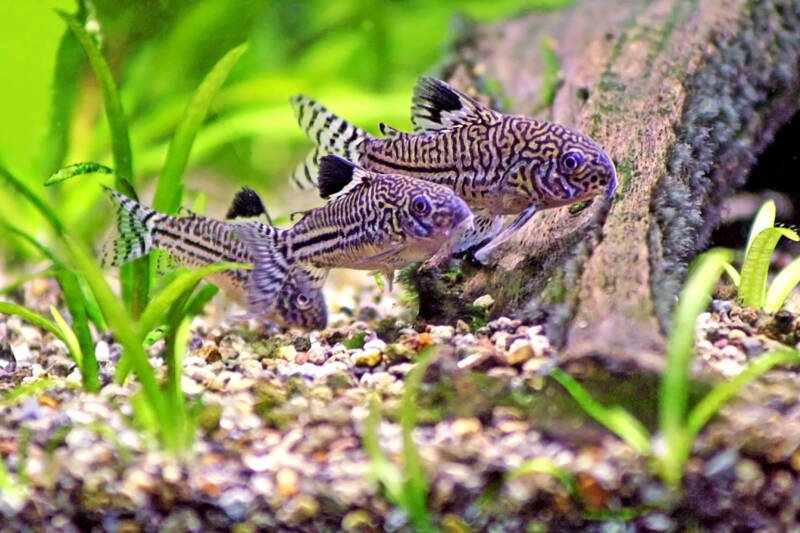
- Difficulty: Easy
- Diet: Omnivore
- Tank Size: 10 gal (40 l)
With over 165 named species of cory catfish, there are incredible options.
Depending on the species, they can range in size from one to four inches (2.5 to 10 cm) in length.
Their top half is covered in bony, protective armor and their flat bellies allow them to cruise along the substrate.
These highly social fish need a group of four or more to allow them to comfortably cruise around looking for food.
In a peaceful tank and with diligent care, these fish have an amazingly long lifespan of 20 years.
A planted tank with a soft, sandy substrate is best for these bottom dwelling fish.
Give them a piece of driftwood or other such hiding place to make their home.
Corys have a pleasant temperament. Not only will they get along with other inhabitants, but they help clean up food and vegetation that fall to the bottom.
14. Kribensis (Pelvicachromis spp.)

- Difficulty: Relatively easy
- Diet: Omnivore
- Tank Size: 20 gal (80 l)
If you are looking for an introduction to cichlid care, including behavior management and breeding, the kribensis is an excellent choice.
There are several species available that do not differ significantly in care, and the most popular one you will see in your local fish store is Pelvicachromis pulcher.
These hardy fish can adapt to a range of water needs, from soft, acidic freshwater to slightly brackish.
A plus for this cichlid: they will not uproot your plants as do other cichlid types.
While peaceful in terms of temperament, this cichlid will establish a decently sized territory of around 12 inches square and needs a large tank.
These fish mate for life and really only defend these territories when mating.
If you keep them with fish that stay in the middle to upper levels of the tank, like zebra danios, small tetras, barbs, guppies or hatchetfish, then kribs make good community tank members.
15. German Blue Ram (Microgeophagus ramirezi)

- Difficulty: Intermediate
- Diet: Omnivore
- Tank Size: 20 gal (80 l)
The beautifully colored German blue ram is another option for a peaceful cichlid.
They are a manageable two to three inches (5 to 7.6 cm) in length and undemanding in their feeding needs.
These fish are slightly more sensitive in their water needs and can be negatively impacted by suboptimal conditions. They need warm, slightly acidic, soft water that is kept exceptionally clean.
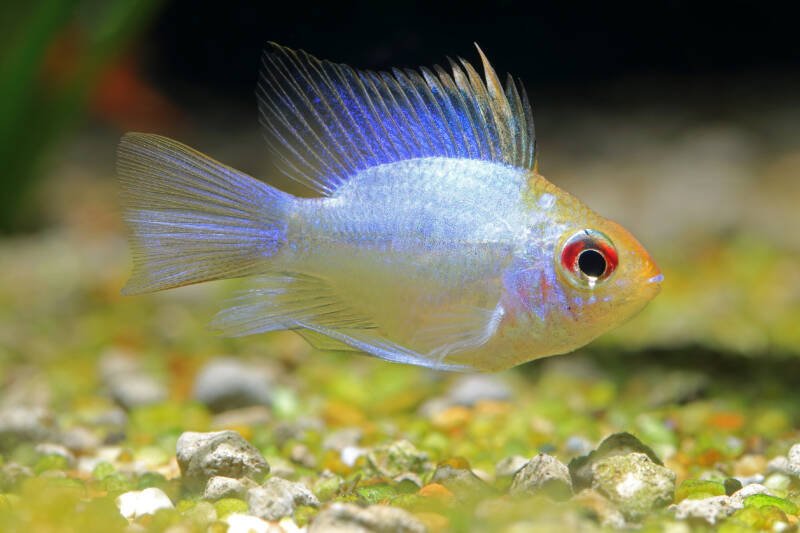
This species can be a bit shy, but when paired with moderately active dither fish, they can be comfortable and active.
Plan on keeping a single ram fish unless you double the tank size.
Most of the time, these fish keep to themselves and do not bother their tankmates. They can become territorial during breeding times and do best in a separate tank in this case.
Rams can dig in the substrate but are generally safe around well-secured aquatic plants and will not uproot them.
16. Clown Pleco (Panaque maccus)
- Difficulty: Easy
- Diet: Omnivore
- Tank Size: 20 gal (80 l)
As far as plecos go, the clown is a great size for someone who does not have space for a large tank.
Its adult size of three to four inches (7 to 10 cm) is reasonable compared to other species, such as the common pleco, that can reach up to 15 inches (38 cm).
This fish minds its own business and gets along well in a community tank, especially with species that prefer the middle to upper levels.
Be aware that if you wish to keep more than one pleco, you will need to increase the tank size.
These fish need space for their own territory, and they are also very messy. In this case, a larger tank equipped with a quality filter is actually easier to keep clean.
Add in some plants to keep your pleco happy.
17. Apisto (Apistogramma spp.)

- Difficulty: Challenging
- Diet: Omnivore
- Tank Size: 50 gal (190 l)
Apistogramma are another smaller cichlid that can be considered for a community tank with caution.
Only reaching a maximum of three to 3.5 inches (7 to 9 cm), with some species significantly smaller, this stunning genus has incredible variations of color, fin shapes, and markings.
Males can be territorial, whereas females have a more pleasant personality.
In a large enough tank and with careful attention to the other species with which the Apistogramma is paired, a community tank is possible.
Pair them with fish that occupy the middle to upper levels and provide plenty of hiding places using rocks and driftwood to break up the line of sight.
These fish require keen attention to their water conditions and cleanliness.
Soft, slightly acidic water and well-planted tanks with minimal water movement will replicate their natural environment.
18. Blue-Eyed Forktail, Pseudomogil spp. (Pseudomugil furcatus)
- Difficulty: Moderate
- Diet: Omnivore
- Tank Size: 20 gal (80 l)
This playful fish has a unique dorsal fin configuration and a deeply forked caudal fin.
The dark coloration at the center of their tail gives the impression of an even larger split, lending them their common name: the forktail rainbowfish.
Although they only reach around two inches (5 cm) in length, you will want to keep a group of at least six in a larger tank.
Forktails are active and get along well with other small, active species, such as danios and rasboras, creating a visually appealing tank.
This fish has a shorter lifespan of around three years.
They need careful attention to the upkeep of their water conditions and a high-quality diet to reach their full potential.
Invest in a heater to keep the water temperature within their narrow range.
19. Odessa Barb (Pethia padamya)

- Difficulty: Easy
- Diet: Omnivore
- Tank Size: 30 gal (110 l)
There is something about the coloration of the Odessa barb’s scales that is simply irresistible.
Males are more colorful with a predominantly red and silver/black body and semi-transparent fins. Females are a golden-brown color.
These fish do best in slightly acidic water that is rich in plant life. Try to replicate these conditions in your tank.
These barbs have a comfortable range of water parameters; as with all fish, keep them consistent.
Odessa barbs are easy to feed but need more frequent meals due to their activity level. A mix of quality vegetable and protein sources is perfect.
They may be a smaller, three-inch (7.6 cm) length, but their high activity level necessitates a larger tank.
They should be kept in a group of at least five, which a 30-gallon tank should easily hold.
20. White Cloud Mountain Minnow (Tanichthys albonubes)
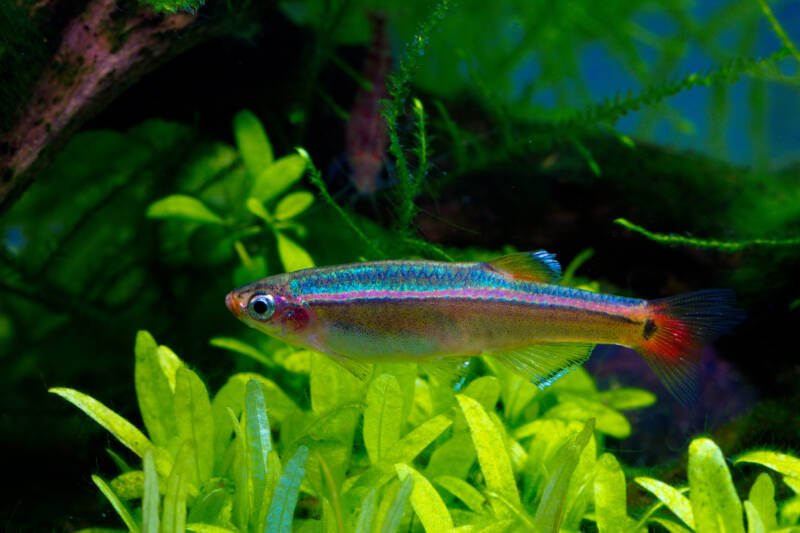
- Difficulty: Easy
- Diet: Omnivore
- Tank Size: 10 gal (40 l)
The White Cloud Mountain minnow is a peaceful, active low-maintenance fish with a few unique requirements.
They are members of the carp family, have a long lifespan of five to seven years, and are excellent for mosquito control.
These hardy fish adapt surprisingly well to life in captivity.
The most unique aspect in caring for these fish is water temperature. White Cloud Mountain minnows are cool water fish that need temperatures between 57 and 72°F (14 to 22°C).
Their tiny adult size of 1.5 inches (4 cm) can make it a challenge to find tank mates that will not view these fish as food.
Add plenty of vegetation to their tank and keep the water clean. These active fish love space in the center where they can swim.
As their natural habitat ranges from mountain rivers to still ponds, water flow can be adjusted to support other species in the aquarium.
21. Kuhlii Loach (Pangio kuhlii)
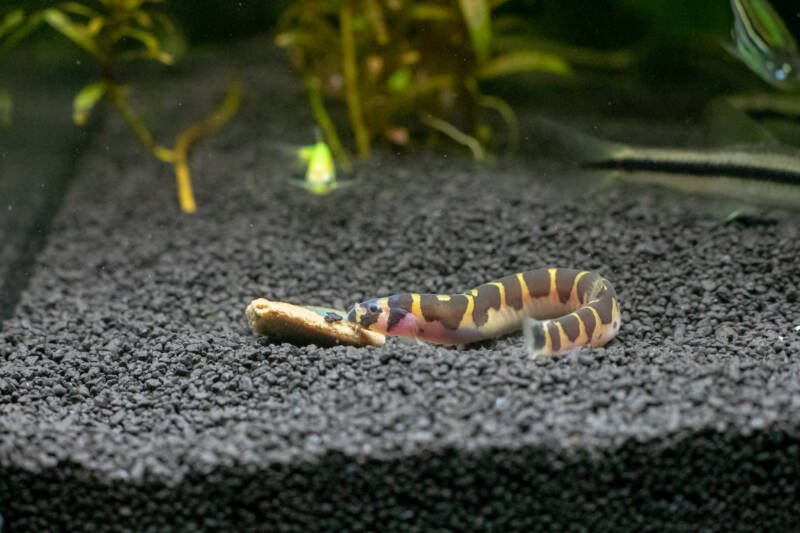
- Difficulty: Intermediate
- Diet: Omnivore
- Tank Size: 15 gal (60 l)
Kuhlii loaches come in a range of base colors from a light pink to a golden yellow alternating with dark vertical patches running the length of its eel-like body.
These fish have sharp spines beneath each eye that can raise as a defense mechanism.
Kuhliis are slightly more difficult to care for. Their scales are thin, leaving them susceptible to bacterial and parasitic infection.
In addition, they can be sensitive to shifts in water parameters. However, with proper care, they can live for up to 10 years.
Kuhlii are bottom feeders with an incredibly low bioload. You will still need aquarium filters, but make sure to cover the intakes.
These loaches need swimming space but are nocturnal and spend most of their time near the substrate, so they pair well with diurnal fish that stick to the middle and upper levels.
22. Gold Barb (Puntius semifasciolatus)
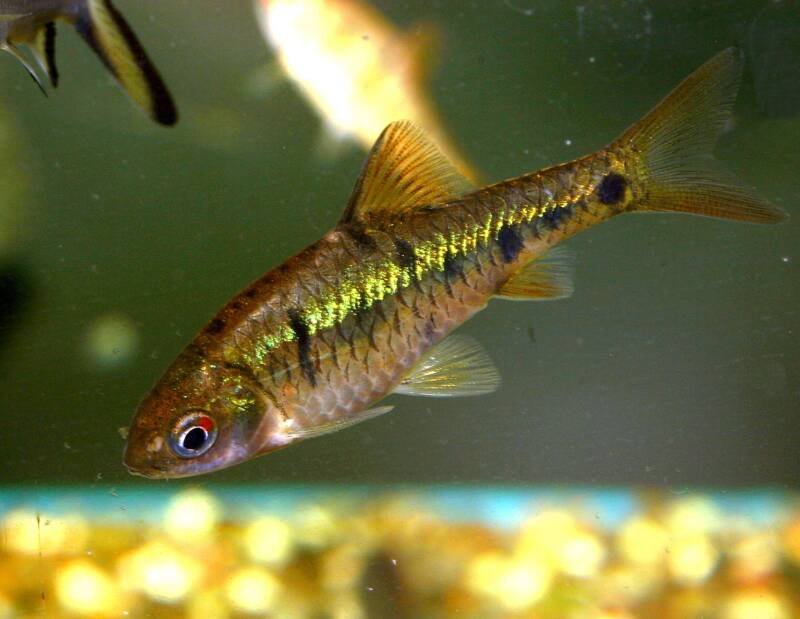
- Difficulty: Easy
- Diet: Omnivore
- Tank Size: 20 gal (80 l)
Golden barbs are active fish that have been selectively bred to obtain a soft yellow color.
Keep these fish in a group of at least six to allow schooling behaviors.
They prefer the middle to bottom levels of the tank and get along well with a variety of tank mates that are similar in size.
The gold barb is a hardy fish that can adapt to a range of water parameters.
They like their water on the cooler end, so pair them with fish needing similar temperatures. High oxygen levels and a moderate current will make this fish feel at home.
These fish are known to take a nibble or two out of aquatic plants, especially mosses.
Keeping them with sturdy or fast-growing varieties may be best if you want live plants.
23. Silver Tetra (Ctenobrycon spilurus)
- Difficulty: Easy
- Diet: Omnivore
- Tank Size: 30 gal (110 l)
The silver tetra has an eye-catching, rhomboid shape and a flash of silver-grey color.
They reach a decent size of around three inches (7.6 cm) and are hardy fish with a large appetite.
They feast on a variety of live prey and plant matter.
Keep silver tetras in a group of six to eight for their most active behavior.
In fact, their activity level is so high, it could prove to be too much if these fish are in a community tank with shy, gentle species.
However, due to their decent size and active nature, they can pair with species you may not normally consider as tetra tank mates, including some cichlids, catfish, or barbs.
They require cooler water temperatures than many other tropical fish and are remarkably easy to breed.
Silver barbs are tough and can adapt to various water conditions, including hard, basic water.
24. X-Ray Tetras (Pristella maxillaris)

- Difficulty: Easy
- Diet: Omnivore
- Tank Size: 15 gal (60 l)
The lovely, transparent x-ray tetra is a tiny micro predator that maxes out at 1.75 inches (4.5 cm).
They make an impressive display in a small school, and their coloration helps them to camouflage when necessary.
A school of five fish is the minimum you should consider for a 15-gallon (60 l) tank.
If you can, going for a larger tank is always preferable to give this active species plenty of space to swim.
X-ray tetras may be small, but their appetites are huge! Take care to not overfeed these fish, as these opportunistic omnivores will eat anything placed in front of them.
This fish is extraordinarily adaptable and can be found in both freshwater and brackish water in the wild, where the plant life and prey are abundant.
In an aquarium, they can thrive in conditions in which other tetras would not do well, including hard and basic water conditions.
25. Festivum Cichlid (Mesonauta festivus)

- Difficulty: Easy
- Diet: Omnivore
- Tank Size: 30 gal (110 l)
The festivum cichlid, also known as the flag cichlid, is a mild-mannered cichlid.
Coming in at around four inches (10 cm) fully grown, their size equates to a manageable tank commitment.
Speaking of commitment, the festivum cichlid can live for up to 10 years.
Their pretty yellow-green color is adorned with a dark stripe that starts near the mouth and runs across the body.
This cichlid is a touch shy but nevertheless curious. They tend to stay around the tank’s middle to lower levels.
Plan on housing a school of at least six fish. Once they are comfortable in the tank, they will exhibit more playful behavior.
Avoid keeping them with smaller fish as these can end up as lunch.
26. Keyhole Cichlid (Cleithracara maronii)

- Difficulty: Easy
- Diet: Omnivore
- Tank Size: 20 gal (80 l)
The keyhole cichlid is a shy, gentle species perfectly suited for a community tank.
While it may not boast the vibrant color of other, well-known cichlids, this fish is visually interesting with a lovely yellowish body and distinct keyhole marking.
Another plus: they do not eat, burrow, or uproot plants, which is good news for planted aquariums.
Their relatively small size, usually less than four inches (10 cm), means you do not have to invest in a massive tank to house them.
The adaptable keyhole can thrive in a range of water conditions, including hard and basic.
For the health of your cichlid, soft and slightly acidic water is best.
They are docile and interact well with similarly peaceful tank mates, allowing the beginner aquarist to enjoy the newness of cichlid keeping without the usual behavior issues.
These fish can pair well with corydoras catfish as well as tetras.
27. Moonlight Gourami (Trichopodus microlepis)

- Difficulty: Intermediate
- Diet: Omnivore
- Tank Size: 20 gal (80 l)
The moonlight gourami is a native of Southeast Asia.
A labyrinth fish, they have a special organ that allows them to intake oxygen directly from the air.
It is an incredibly easy-to-care-for species that is suitable for both intermediate and advanced aquarists.
They are peaceful and feature shimmering, silver coloration all over their body.
They are a little larger than some of the popular community tank species, coming in at around five inches (13 cm) fully grown.
However, they will gently cruise around the tank, not bothering the other inhabitants.
Males can become slightly territorial as they age or following breeding.
A tank with moonlight gouramis should have a low water current, warm water, and plenty of plants (including floating ones) to mimic their natural habitat.
Select broad-leaf plants as moonlight gouramis can nip at fine-leaf ones.
28. Glass Catfish (Kryptopterus vitreolus)
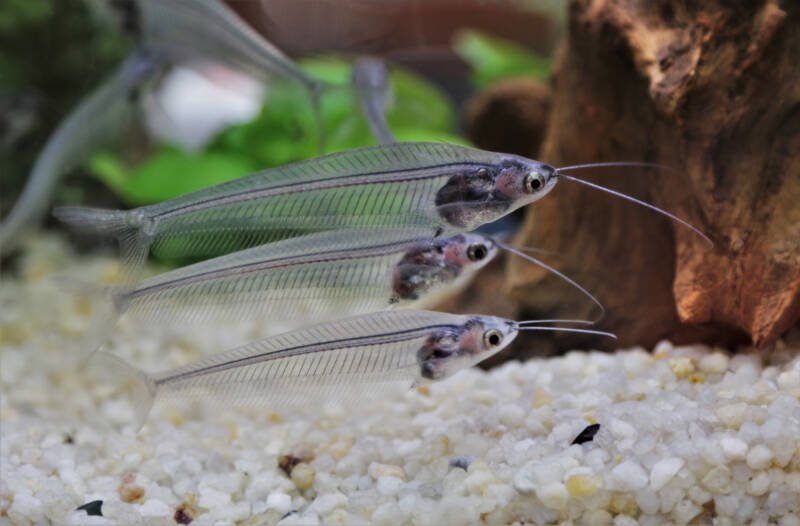
- Difficulty: Intermediate
- Diet: Omnivore
- Tank Size: 30 gal (110 l)
Catfish that are not specifically bottom dwellers? And transparent?
Yes and yes! The glass catfish is a unique species from Thailand that favors the middle levels of rivers with medium flow rates.
As a method of camouflage, their bodies are completely see-through, and aquarists can view the fish’s spine and inner organs.
They are larger than you would think, reaching between four to six inches (10 to 15 cm) in length, and have a long lifespan of seven to eight years of age.
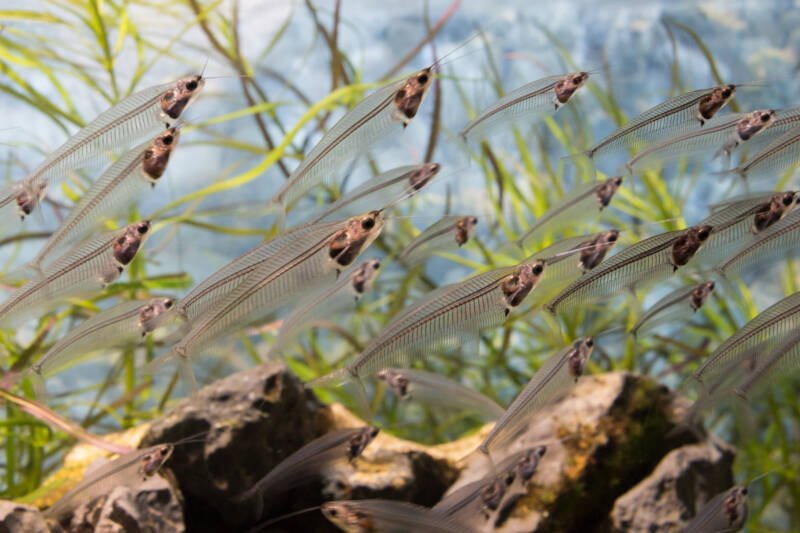
This species needs to be in a group of at least five in a tank with plenty of live plants.
You will need to pay strict attention to water quality.
There is a slim margin in their tolerance ranges, so we recommend that you have experience with adjusting water parameters.
29. Flag Acara (Laetacara curviceps)
- Difficulty: Easy
- Diet: Omnivore
- Tank Size: 20 gal (80 l)
Although this fish does not receive the press that more flashy and colorful cichlid species do, they are an interesting fish that deserves a second look.
The flag acara reaches a maximum length between 3.5 to four inches (9 to 10 cm) and is adept at color changing.
Not only can they shift their background color from a lighter tan or yellow to green/blue in seconds, but the prominent black stripe along their midline can fade or deepen depending on their mood.
This fish prefers calm, slow-moving waters in the tank to replicate their natural environment.
They love a well-planted tank, but unlike other cichlids, they do not uproot plants, nor do they require a cave to claim as territory.
Many owners report that they were able to tame their acara and teach it to accept food from their hand.
30. Common Hatchetfish (Gasteropelecus sternicla)
- Difficulty: Intermediate
- Diet: Carnivore
- Tank Size: 20 gal (80 l)
We have listed the common hatchetfish here, but there are several genus and species from which to choose, offering an impressive range of colors and patterns.
Hatchetfish have an eye-catching body shape with extended abdomens that give them an axe-like look.
This surface-dwelling fish is an active hunter. They occasionally catch their prey by jumping from the water, so make sure your tank lid is secure.
They are best kept in groups of at least six.

They may scuffle a bit among themselves, but they do not bother other species.
Always quarantine this fish and look for signs of ich before adding them to your tank.
While they are not the easiest fish to keep, they are nevertheless worth the extra effort.
Stay on top of water conditions and strive for a peaceful mix of species in the tank to keep your hatchetfish healthy and happy.
31. Dwarf Rainbowfish (Melanotaenia maccullochi)
- Difficulty: Intermediate
- Diet: Omnivore
- Tank Size: 15 gal (60 l)
The dwarf rainbowfish is a pretty fish with a delightful personality.
Their colors mature as they age, so be patient as you await the development.
These fish do not go over three inches (8 cm) in length and have a high activity level, so plan to provide some swimming space.
This movement can bring visual interest to the top level of tank.
Just make sure to pair them with other species that will not be stressed by their swimming.
Rainbowfish are most comfortable in a group of at least six with more females than males.
They work well in a community tank when paired with other small, social fish.
We recommend that you have a bit of experience before taking on the rainbowfish.
These fish need a mature tank and can become susceptible to disease if constantly stressed.
32. Dwarf Neon Rainbowfish (Melanotaenia peacox)
- Difficulty: Easy
- Diet: Omnivore
- Tank Size: 20 gal (80 l)
Another lovely rainbowfish option is the dwarf neon. These fish are inexpensive and easy to find both in local fish stores and online.
They have beautiful, iridescent scales that can appear pink or blue depending on the light.
Males have contrasting red dorsal and ventral fins while the females’ fins are yellow.
They stay small, between two-three inches (5-7 cm) in length, and need to be in a school of no fewer than six fish with more females than males.
Watch for aggression among males as the dominant one can harass weaker ones.
Stay on top of your water’s pH level as this species cannot tolerate fluctuations.
Poor water conditions will cause them to be susceptible to disease, such as ich.
They can nibble on plants in the aquarium, so either select fast-growing varieties or ones with tougher leaves.
Provide an alternate source of vegetable matter to satisfy these omnivores’ needs.
33. Boesemani Rainbowfish

- Difficulty: Easy
- Diet: Omnivore
- Tank Size: 30 gal (110 l)
Boesemani rainbowfish draw the eye with their two-tone coloration of blue, green, and purple in front and red, orange, yellow in back.
Males can have a curve to their back and are larger than females.
Their personality is calm but active, so make sure the other inhabitants can tolerate the Boesemani’s activity levels.
Males have an interesting display behavior where they flare their fins to ward off rivals or impress females, which can be fun to watch.
These fish need a neutral pH level but tolerate an impressive range of water temperatures. Keep the water hard with a low current.
When it comes to this rainbowfish, there are many varieties from which to choose.
Consider the red neon blue-eyed rainbow for its intense hue or the Furcata rainbow for its unique fin shapes.
Research biochemist Gary Lange is a renowned breeder of Boesemani rainbowfish. His strains are reported to have incredible colors.
Closing Thoughts
Creating a peaceful community tank is an enjoyable task when considering the fish mentioned above.
Not only will you have colorful fish and a visually attractive tank, but their calm temperaments make everything less stressful.